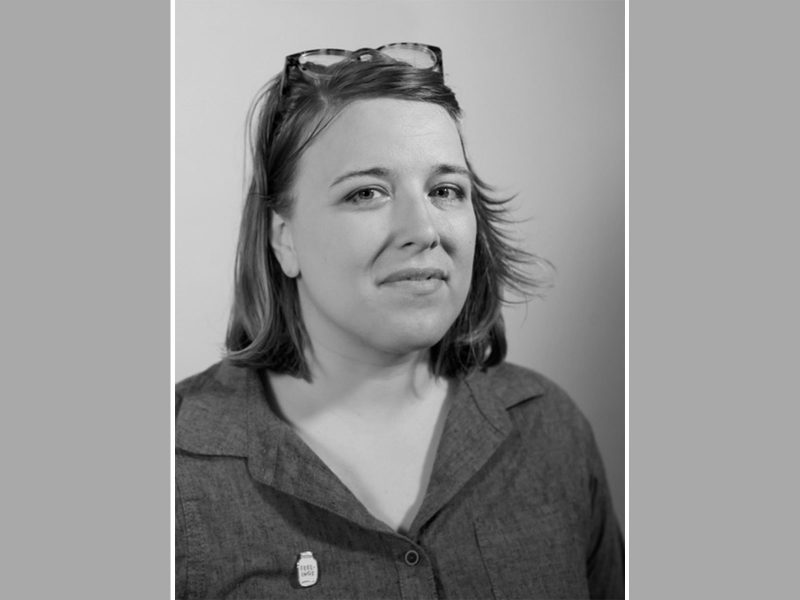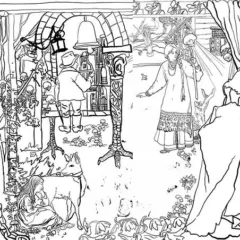
When you’re an ex-Philly resident meeting another ex-Philly resident in Portland, ME, the obvious attire of choice is a Gritty-themed shirt from an artist on Etsy. The shirt– DIY, joyful, and a bit unexpected– is oddly fitting for a meeting with Kelsey Halliday Johnson, Executive Director of SPACE– an independent “maker hub” in Portland.
Kelsey’s work in Philadelphia included sojourns at Locks Gallery, the James Michener Museum, and elsewhere. As a member of Vox Populi, Kelsey, who has a background in visual art, was deeply embedded in Philadelphia’s DIY-alternative and established arts communities. She moved from Philly to Portland in 2017 when she accepted the role at SPACE.
The SPACE building, formerly a historic hotel, houses gallery spaces, offices, artist studios (over 30 in total), a performance venue, and a studio apartment for artists-in-residence (which to my delight, comes with a Murphy bed). Kelsey remarks: “We’re part programming hub, part grantmaker, part artists’ studios, and artist community. So SPACE is a bunch of different paths.” She cheekily adds, “And unfortunately, I like all of them.”
It is clear that Kelsey’s energy and passion, as well as that of her staff, volunteers, and other affiliates, has played a big role in positioning SPACE as a community anchor. On trading the Benjamin Franklin bridge for Maine’s ubiquitous lighthouses in 2017, Kelsey reveals:
There were two urges to move to Maine from Philadelphia: the allure of getting to work for an arts organization offering a deeper array of resources to living artists…, and the personal call to be closer to nature. I’ve grown up as someone deeply trained in the New York art historical narratives, and naturally migrated towards someone seeking alternate communities and building connections with artists further afield. It feels like a crucial ideological position to live, work, and try to amplify artistic voices elsewhere […] My career path has been a bit of a sampler in trying out different institutional types and seeing what felt healthy.
In comparing Philly and her new stomping grounds of Portland, Kelsey notes the high level of community participation in the arts in her new city:
“One thing I know is different is about access to the arts. Right before the pandemic hit there was new NEA data that came out that showed three out of every four adults in the greater Portland area were attending performing arts events. It’s an audience attendance number that’s only trumped by metro Denver. That kind of real widespread community connection over the arts has a deep impact on quality of life, ideas, conversations, and a baseline of joy.”

While she still has an incredible amount of love for the Philly arts scene, Kelsey says:
“SPACE seemed to offer something that I wasn’t finding in Philadelphia [at the time of my departure]: an independent contemporary arts organization that bought their building and had studios for working artists, a residency for visiting artists, and was making a commitment to paying all artists they were working with. [SPACE offering] grantmaking was the icing on the cake.”
Adding metaphorical sprinkles to that cake icing, Johnson said SPACE’s own granting program, the Kindling Fund, (which, like Philadelphia’s Velocity Fund, is an arm of the Andy Warhol Foundation Regional Regranting Program), has been especially important to the Maine Arts community during the pandemic. The fund distributes $65,000 annually to Maine-based artists. More recently, SPACE was awarded a $250,000 grant from the National Endowment for the Arts through the American Rescue Plan. Kelsey remarks,
“With SPACE’s work as a funder of local arts in mind, you can’t talk about SPACE without talking about activism. To work in art and be firmly against exploitation—to believe that people should be paid for their craft, that art is labor that should be fairly compensated, that everyone deserves to live a life of dignity with a roof over their heads, to eschew the nobility of the starving, suffering artist barely making it by—seems rare enough on its own.”
As Executive Director, Kelsey perpetuates SPACE’s 22-year mission of equity.
“We need abundance to discover new frontiers of experimentation, scale, depth of thinking, and artistic capacity. And we need real solutions for income inequality in the so-called ‘art world.’”
When I visited SPACE, the exhibition on display was What Rhymes with Freedom? Visions of Decarceration, a show exploring aspects of the United States’s penchant for imprisonment. (I previously reviewed a show with similar themes at Philly’s own Asian Arts Initiative.) Crucially, What Rhymes with Freedom sought not only to reinforce the beliefs of audience members who support decarceration, but also to educate those who do not. Along with video, audio, textiles, archival broadsides, and a whole host of historical ephemera, What Rhymes with Freedom hosted a tucked away reading room where visitors were invited to sit and pore over texts on incarceration, anti-fascism, and civil rights. Lastly, What Rhymes with Freedom offered an opportunity to literally turn thoughts into action. Visitors were encouraged to write postcards to detainees at the Mesa Verde ICE Processing facility as part of a larger overall SPACE collaboration, Voices in the Shadow.

When I visited Portland in mid-October, 2021, the town was plastered with more signs for political causes and candidates than it had blades of grass. (There were even signs on the highway medians.) For a small city, it crackled with that tense, anxious energy that comes before any given election day. As our conversation veered from local candidates to the messiness of being both a Sierra Club supporter and housing advocate, or supporter of the failed effort to close Maine’s Long Creek Youth Jail, it became clear that Kelsey’s professional role at SPACE also feeds the activist part of her soul.
And yet for every socially-conscious art project I encounter, the question of utility remains. Is the very critical work that hubs like SPACE do—supporting artists and creatives and helping them to flourish— enough? Should everyone who cares about change start running for office? Is what we do, as arts and humanities professionals, ornamental? Escapism? (And if so, is that a bad thing?) Or does working in this sphere of storytelling and expression, of craft and labor and connection, fulfill a unique and valuable niche on its own?
Acknowledging this constant tension among duty, passion, and skill, Kelsey has found a way to live on the knife’s edge. She remarks:
“I try to bring my full self to work everyday, and frankly, [I] have moved on from working in settings where that was not possible. However, I recognize there are different modalities I use in different places. At work, we have the opportunity to offer programmatic offerings as entry points] into ideas and issues […] I see my role at Space as building a platform for artists to be the activists […] As an individual, I can be more direct and [I can] agitate.”
“Using my voice and my experience to talk with peers and develop a list of changes, demands, and recommendations for the field feels like the best way to use my personal activism for something that helps build a healthier foundation for myself as a leader.”
The ongoing pandemic also has strengthened her convictions that what SPACE brings to the table is vitally necessary.
“In an era of plague and isolation, art connects us with our common humanity and soul. Music, storytelling, and creativity helped me make it through this moment, as I know it did for so many others.”
So when it comes to art and activism, and where these roles begin and end, perhaps the way Kelsey frames it can be a guide:
“Why is art important? Art is a demonstrable written history using alternative languages. It speaks truth to power in different ways […] Art is a radical form of free speech, and in an era of ever-encroaching fascism, it’s crucial that we hold on to every pillar of free expression.”










